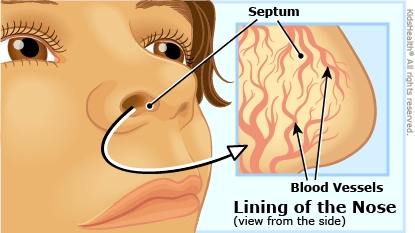After Nasal Cautery: How to Care for Your Child
Nasal cautery is a short procedure that usually can prevent future nosebleeds. Your child's nose had blood vessels that were bigger and closer to the skin's surface than usual and were causing nosebleeds. The health care provider touched the ends of these with either a chemical called silver nitrate or a small electric current. This procedure — called cautery (KOH-teh-ree) or cauterization — seals the end of the vessels so they can't bleed.
For a few hours after cautery with silver nitrate, some kids feel a little pain or burning in their nose. Kids who had general anesthesia to sleep through the procedure may have some nausea or vomiting afterward.


-
Make sure your child follows the health care provider's instructions about not blowing, rubbing, or picking the nose after the cautery. Instead of blowing their nose, they can gently wipe the nostrils one at a time. They should also try not to bend over, do strenuous exercise, or lift heavy things until the health care provider says it's OK.
-
As instructed, apply a small amount of petroleum jelly or antibiotic ointment inside the nostrils (on the center wall between them) twice a day with a cotton swab or your finger to prevent dryness.
-
If your child complains of a burning feeling in the nose, squirt nasal saline to rinse it.
-
For pain, you can give your child acetaminophen (Tylenol® or a store brand). Follow the directions on the label for how much medicine to give and how often. Do not give ibuprofen or aspirin, which can increase the risk of bleeding.
Sometimes a nosebleed happens after cautery, especially if a child blows, rubs, or picks their nose. Follow these instructions:
-
Stay calm and comfort your child.
-
Have your child sit up and tilt the head slightly forward to keep blood from running down the back of the throat.
-
Have your child use the thumb and index finger to pinch the nostrils or soft part of the nose together and hold it constantly for 10 minutes. If the bleeding hasn't stopped after 10 minutes, pinch the nose shut for another 10 minutes.
-
If your health care provider recommended it, use a nasal decongestant spray for a nosebleed that does not stop.

Your child:
-
still gets nosebleeds as they did before the procedure
-
has blood going down the back of the throat even with the head tilted forward. This might be a sign of a more serious, less common condition called a posterior (back of the nose) nosebleed.
-
has pain or burning not helped with nasal saline or acetaminophen
-
has a fever

Your child:
-
still has nose bleeding after pinching the nose for a total of 20 minutes
-
is bleeding heavily or has lost a large amount of blood (more than 1 cup)
-
has a new nosebleed from an injury or blow to the head or face
-
feels weak or faint

What causes nosebleeds? While nosebleeds can happen from a blow to the nose, in kids many happen because they pick at crusty nasal membranes that are dried out from dry climates or heated indoor air. This can break the tiny, fragile blood vessels in the septum (the wall that divides the nose into two halves), causing blood to come out of the nostril. Nosebleeds also can happen if nasal membranes get irritated from common colds or allergies.
What else can help prevent nosebleeds? Don't overheat your home, which can dry the lining of the nose and make it bleed more easily. Consider using a humidifier in your child's bedroom.